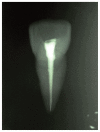Root canal obturation: experimental study on the thermafil system related to different irrigation protocols
- PMID: 25506413
- PMCID: PMC4252860
Root canal obturation: experimental study on the thermafil system related to different irrigation protocols
Abstract
Aim: The aim of this study was to stress the ability of a specific obturation technique (thermafil technique) to seal root canal system in presence or absence of smear layer.
Methodology: Sixteen monoradicular teeth, extracted for periodontal reasons, were collected for this study. All specimens were prepared with nickel-titanium rotary files, and then divided into two groups: for each group was applied a different kind of irrigation method, verifying the effectiveness in removing the smear layer, thus rendering the dentinal tubules more permeable for penetration of softened gutta-percha. Thermafil system was used to fill the root canals, and then all the specimens were observed under scanning electron microscope (SEM).
Results: The results showed that the Group which followed irrigation only with sodium hypochlorite exhibited significantly less gutta-percha tags when compared to the second Group, which was irrigated with sodium hypochlorite and EDTA.
Conclusion: The thermafil systems have a very good quality of compression and fluency that permit to gain a good seal of endodontic space; furthermore it allows the penetration of gutta-percha with the formation of numerous of gutta-percha tags inside the dentinal tubules above all when smear layer is reduced or eliminated.
Keywords: EDTA (Ethylene diaminetetraacetic acid); dentinal tubules; gutta-percha tags; smear layer; sodium hypochlorite; thermafil.
Figures









Similar articles
-
Effectiveness of three different retreatment techniques in canals filled with compacted gutta-percha or Thermafil: a scanning electron microscope study.J Endod. 2009 Oct;35(10):1433-40. doi: 10.1016/j.joen.2009.06.002. Epub 2009 Aug 22. J Endod. 2009. PMID: 19801246 Clinical Trial.
-
[Studies comparing the efficacy of root canal filling with gutta-percha lateral condensation and Thermafil obturators].Ann Acad Med Stetin. 2000;46:317-30. Ann Acad Med Stetin. 2000. PMID: 11712315 Polish.
-
Apical sealing ability of glass ionomer sealer with and without smear layer.J Endod. 1998 May;24(5):343-5. doi: 10.1016/S0099-2399(98)80131-3. J Endod. 1998. PMID: 9641110
-
Dentinal wall adaptation of thermoplasticized gutta-percha in the absence or presence of smear layer: a scanning electron microscopic study.J Endod. 1993 Nov;19(11):558-62. doi: 10.1016/S0099-2399(06)81286-0. J Endod. 1993. PMID: 8151244
-
Effectiveness of different final irrigant activation protocols on smear layer removal in curved canals.J Endod. 2010 Aug;36(8):1361-6. doi: 10.1016/j.joen.2010.03.037. Epub 2010 May 13. J Endod. 2010. PMID: 20647097 Clinical Trial.
Cited by
-
Comparative assessment of vertical fracture resistance in endodontically treated roots with different obturating systems and techniques: a systematic review and network meta-analysis of in vitro studies.BMC Oral Health. 2024 Nov 27;24(1):1439. doi: 10.1186/s12903-024-05111-x. BMC Oral Health. 2024. PMID: 39604933 Free PMC article.
-
Clinical studies on core-carrier obturation: a systematic review and meta-analysis.BMC Oral Health. 2017 Dec 29;17(1):167. doi: 10.1186/s12903-017-0459-1. BMC Oral Health. 2017. PMID: 29284463 Free PMC article.
-
Evaluation of the Sealing Ability of Three Obturation Techniques Using a Glucose Leakage Test.Biomed Res Int. 2017;2017:2704094. doi: 10.1155/2017/2704094. Epub 2017 Jun 19. Biomed Res Int. 2017. PMID: 28706942 Free PMC article.
References
-
- Stoll R, Betke K, Stachniss V. The influence of different factors on the survival of root canal fillings: a 10-year retrospective study. J Endod. 2005;31:783–90. - PubMed
-
- Kytridou V, Gutmann JL, Nunn MH. Adaptation and seal ability of two contemporary obturation techniques in the absence of the dentinal smear layer. Int Endo J. 1999;32:464–474. - PubMed
-
- Naidorf IJ. Clinical microbiology in endodontics. Dent Clin North Am. 1974;18:329–44. - PubMed
-
- Saunders WP, Saunders EM. Influence of smear layer and the coronal leakage of thermafil and laterally condensed gutta percha root fillings with a glass ionomer sealer. J Endod. 1994;20:155–8. - PubMed
-
- Yoshida M, Fukushima H, Yamamoto K, Ogawa K, Toda T, Sagawa H. Correlation between clinical symptoms and microorganisms isolated from root canals of teeth with periapical pathosis. J Endod. 1987;13:24–8. - PubMed
LinkOut - more resources
Full Text Sources
